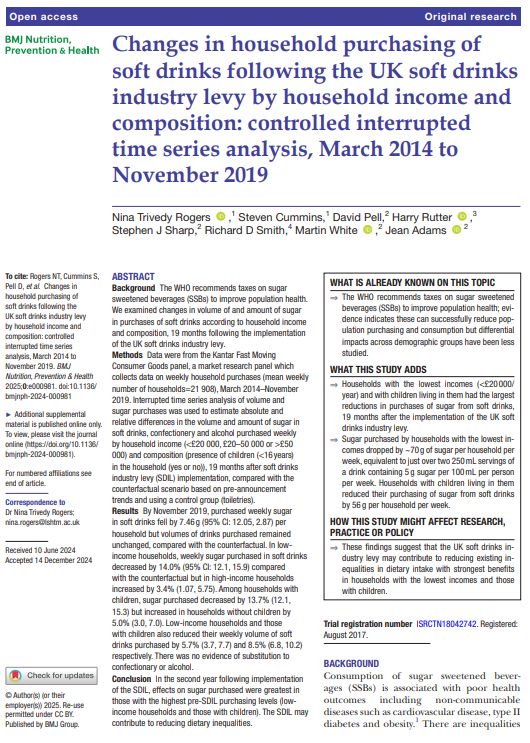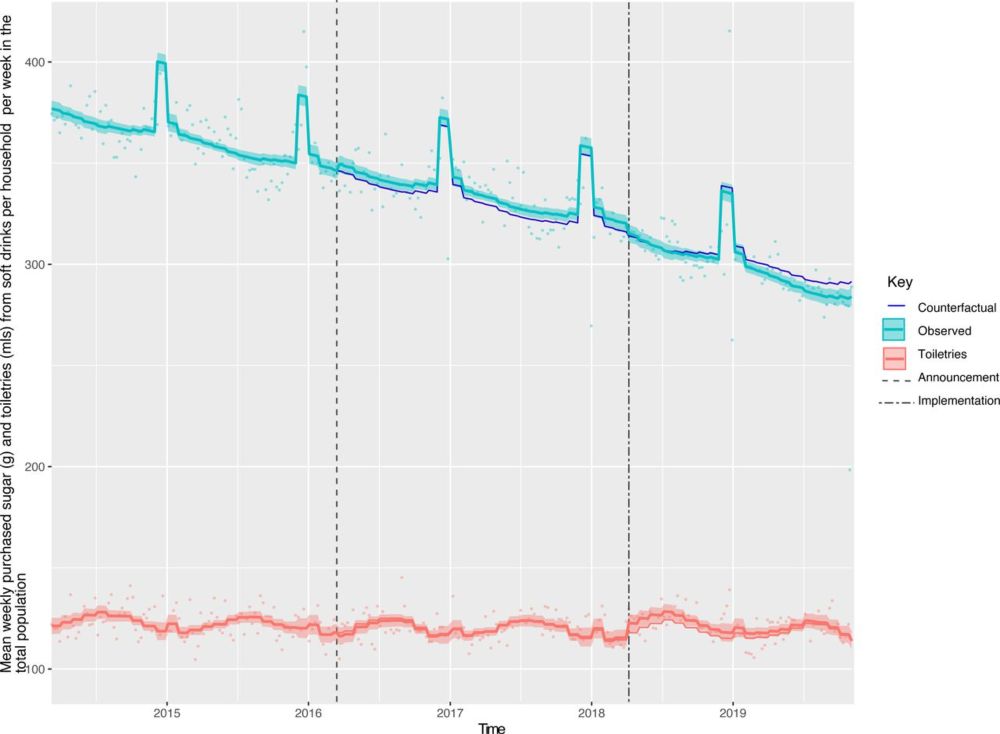
Research Fellow @LSHTM @PHILabLSHTM
Visiting scientist @MRC_EPID
www.mrc-epid.cam.ac.uk/blog/2023/11...
(3/4)

www.mrc-epid.cam.ac.uk/blog/2023/11...
(3/4)
www.mrc-epid.cam.ac.uk/blog/2024/07...
(2/4)

www.mrc-epid.cam.ac.uk/blog/2024/07...
(2/4)

🎧 Catch up here (my segment starts at 1:27:47) www.thetimes.com/radio/show/2...
@lshtm.bsky.social

🎧 Catch up here (my segment starts at 1:27:47) www.thetimes.com/radio/show/2...
@lshtm.bsky.social

19 months after the introduction of the UK’s Sugar Drinks Industry Levy, households with children bought fewer sugary drinks!
But researchers also found that sugary drink purchases went up by 14% in households WITHOUT children.
Read - buff.ly/kgiuoAs

19 months after the introduction of the UK’s Sugar Drinks Industry Levy, households with children bought fewer sugary drinks!
But researchers also found that sugary drink purchases went up by 14% in households WITHOUT children.
Read - buff.ly/kgiuoAs
Takeaways can negatively impact the diet and diet-related health outcomes of local residents
Local authority urban planners can deny planning for new takeaways in management zones around schools
But what are the long term impacts of these exclusion zones?
Read - buff.ly/S04RDSP

Takeaways can negatively impact the diet and diet-related health outcomes of local residents
Local authority urban planners can deny planning for new takeaways in management zones around schools
But what are the long term impacts of these exclusion zones?
Read - buff.ly/S04RDSP
“Science belongs to humanity. We must protect it, prioritize it, and give it the freedom it needs to flourish.”
At the launch of the EU’s “Choose Science - Choose Europe” initiative, she announced four key actions.
🧵1/3
“Science belongs to humanity. We must protect it, prioritize it, and give it the freedom it needs to flourish.”
At the launch of the EU’s “Choose Science - Choose Europe” initiative, she announced four key actions.
🧵1/3
Richard Westcott talks to experts Jonathan Stieglitz, IAST, & @martinwhite33.bsky.social, @mrcepid.bsky.social, in this month's #CrossingChannels #Podcast
Listen: pod.fo/e/2c3eac

Richard Westcott talks to experts Jonathan Stieglitz, IAST, & @martinwhite33.bsky.social, @mrcepid.bsky.social, in this month's #CrossingChannels #Podcast
Listen: pod.fo/e/2c3eac
Our Mick Armstrong spoke movingly about the shame and trauma of the families whose children need to have decayed teeth extracted in hospital.

Our Mick Armstrong spoke movingly about the shame and trauma of the families whose children need to have decayed teeth extracted in hospital.
nutrition.bmj.com/content/bmjn...
nutrition.bmj.com/content/bmjn...
Great to see @katfoodjenner.bsky.social from @oha-updates.bsky.social on the panel, sharing evidence of its impact and future potential.


Great to see @katfoodjenner.bsky.social from @oha-updates.bsky.social on the panel, sharing evidence of its impact and future potential.

Conference dates: Wednesday 10th - Friday 12th September 2025, with an ECR day on Tuesday 9th
Where: Bradford
Submit your abstract here: bit.ly/3PKGo2k
Submission deadline: 23:59 GMT, Monday 24th February 2025
📷 Neil Turner

Conference dates: Wednesday 10th - Friday 12th September 2025, with an ECR day on Tuesday 9th
Where: Bradford
Submit your abstract here: bit.ly/3PKGo2k
Submission deadline: 23:59 GMT, Monday 24th February 2025
📷 Neil Turner
Tax works
Sugar consumption edition
Helpful reminder
To remind for almost any non communicable disease where "lifestyle" (term used advisedly) is at play the real answers are in
1. regulating industries that produce harm, and products
....

Tax works
Sugar consumption edition
Helpful reminder
To remind for almost any non communicable disease where "lifestyle" (term used advisedly) is at play the real answers are in
1. regulating industries that produce harm, and products
....
.http://www.bmj.com/content/388/bmj.r106.short?rss=1
Take great care
Calorie labels are not a substitute for regulation of advertising, product
But will be sold as such
Labels have great limits
.http://www.bmj.com/content/388/bmj.r106.short?rss=1
Take great care
Calorie labels are not a substitute for regulation of advertising, product
But will be sold as such
Labels have great limits
📄: nutrition.bmj.com/content/earl...

📄: nutrition.bmj.com/content/earl...

📄: nutrition.bmj.com/content/earl...
www.ft.com/content/b503...
A. It'll not be solved by
Celeb Chefs in Schools
Self regulation
Cookery classes
Campaigns
B. It'll be solved by
govt regulation
With interventions focused on price, advertising, reformulation, availability

www.ft.com/content/b503...
A. It'll not be solved by
Celeb Chefs in Schools
Self regulation
Cookery classes
Campaigns
B. It'll be solved by
govt regulation
With interventions focused on price, advertising, reformulation, availability


Nestlé adds sugar to infant milk sold in poorer countries, but not in western countries
www.theguardian.com/global-devel...

Nestlé adds sugar to infant milk sold in poorer countries, but not in western countries
www.theguardian.com/global-devel...

